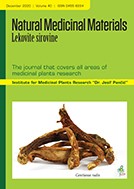Department of Pharmacognosy, Faculty of Pharmacy, University of Belgrade , Belgrade , Serbia
Department of Pharmacognosy, Faculty of Pharmacy, University of Belgrade , Belgrade , Serbia
Department of Botany, Faculty of Pharmacy, University of Belgrade , Belgrade , Serbia
Department of Pharmacognosy, Faculty of Pharmacy, University of Belgrade , Belgrade , Serbia
Fruticin (amorphin) is a constituent of the fruit of the false indigo-bush (Amorpha fruticosa L.), which belongs to the class of rotenoid glycosides, and shows several interesting pharmacological activities. The aim of this study was to isolate and chemically characterize this natural product, as well as to determine the optimal period of the year for A. fruticosa fruits collection. Fruticin was obtained by re-crystallization of the precipitate that formed after partial evaporation of the extract, prepared by 3-fold extraction of powdered plant material by chloroform - ethanol (1:1, v/v). The structure of the final product was determined by various techniques of instrumental analysis (NMR, UV and MS), and confirmed by comparing the obtained spectra with corresponding data in available literature. The content of fruticin in A. fruticosa fruit was determined by LC-DAD-MS, using the external standard method based on the constructed calibration curve. Limits of detection (LOD) and quantification (LOQ) were also determined. A substantial increase in fruticin content was observed during the ripening period (>50%). It has also been established that the optimal time for fruit collection is mid-December. Obtained results indicate that the content of fruticin in the A. fruticosa fruit is highly dependable on the time of collection. Since the biosynthesis of secondary plant metabolites is influenced not only by the time of collection, but by numerous other factors as well, additional studies are needed to define, with greater certainty, the conditions that are necessary for design of prospective efficient and sustainable production process.
This is an open access article distributed under the Creative Commons Attribution License which permits unrestricted use, distribution, and reproduction in any medium, provided the original work is properly cited.

The statements, opinions and data contained in the journal are solely those of the individual authors and contributors and not of the publisher and the editor(s). We stay neutral with regard to jurisdictional claims in published maps and institutional affiliations.